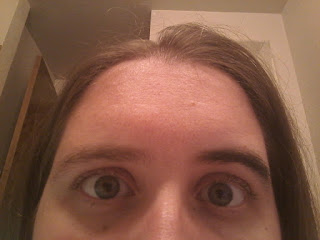The Toilette of Health, Beauty and Fashion (Boston, 1833):
To Blacken the Eye lashes and Eye browsThis same receipt appears, verbatim, in The Book of Health and Beauty (London, 2nd edition 1837); it is also repeated in the The American Family Keepsake (Boston, 1849) and One Thousand Things Worth Knowing (New York, 1854). The Amateur (1851) mentions burned cork used as stage makeup.
The simplest preparations for this purpose are the juice of elder berries; burnt cork, or cloves burnt at the candle. Some employ the black of frankincense, resin, and mastic; this black, it is said, will not come off with perspiration.
So, does it work?
 |
| Burnt clove applied to my right eyebrow and lashes. I suspect there's no such thing as a flattering eyebrow selfie. |
 |
| And burnt cork, again on the right. |
No comments:
Post a Comment
Thanks for commenting!